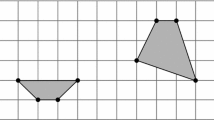Abstract
This paper examines the expected complexity of boundary problems on a set ofN points inK-space. We assume that the points are chosen from a probability distribution in which each component of a point is chosen independently of all other components. We present an algorithm to find the maximal points usingKN + O (N1−1/K log1/K N) expected scalar comparisons, for fixedK≥ 2. A lower bound shows that the algorithm is optimal in the leading term. We describe a simple maxima algorithm that is easy to code, and present experimental evidence that it has similar running time. For fixedK ≥ 2, an algorithm computes the convex hull of the set in 2KN + O(N1−1/K log1/KN) expected scalar comparisons. The history of the algorithms exhibits interesting interactions among consulting, algorithm design, data analysis, and mathematical analysis of algorithms.
Similar content being viewed by others
References
Becker, R. A., L. Denby, R. McGill, and A. R. Wilks, Analysis of data from the Places Rated Almanac,The American Statistician,41(3) (1987), 169–186.
Bentley, J. L., Multidimensional divide-and-conquer,Communications of the Association for Computing Machinery,23(4) (1980), 214–229.
Bentley, J. L., and M. I. Shamos, Divide and conquer for linear expected time,Information Processing Letters,7(2) (1978), 87–91.
Bentley. J. L., H. T. Kung, M. Schkolnick, and C. D. Thompson, On the average number of maxima in a set of vectors and applications,Journal of the Association for Computing Machinery,25(4) (1978), 536–543.
Bentley, J. L., B. W., Weide, and A. C. Yao, Optimal exptected-time algorithms for closest point problems,ACM Transactions on Mathematical Software,6(4) (1986), 563–580.
Boyer, R., and D. Savageau,Places Related Almanac (Revised Edition), Rand McNally, 1985.
Clarkson, K. L., and P. W. Shor, Applications of random sampling in computational geometry, II,Discrete and Computational Geometry,4(5) (1989), 387–421.
Devroye, L.. A note on finding convex hulls via maximal vectors,Information Processing Letters,11(1) (1980), 53–56.
Floyd, R. W., and R. L. Rivest, Expected time bounds for selection,Communications of the ACM,18(9) (1975), 165–172.
Golin, M., and R. Sedgewick, Analysis of a simple yet efficient convex hull algorithm,Proceedings of the Fourth Annual Symposium on Computational Geometry, 1988, pp. 153–163.
Graham, R. L., An efficient algorithm for determining the convex hull of a finite planar point set,Information Processing Letters,1 (1972), 132–133.
Kung, H. T., F. Luccio, and F. P. Preparata, On finding the maxima of a set of vectors,Journal of the Association for Computing Machinery,22(4) (1975), 469–476.
Monier, L., Combinatorial solutions of multidimensional divide-and-conquer recurrences,Journal of Algorithms,1(1) (1980), 60–74.
Preparata, F. P., and S. J. Hong, Convex hulls of finite sets of points in two and three dimensions,Communications of the Association for Computing Machinery,20(2) (1977), 87–93.
Preparata, F. P., and M. I. Shamos,Computational Geometry, Springer-Verlag, 1985.
Seidel, R., A convex hull algorithm optimal for points in even dimensions, M.Sc. Thesis, Technical Report 81-14, Department of Computer Science, University of British Columbia, Vancouver, 1981.
Urgel, J., Private communication, Harvard Business School, April–May 1989.
Author information
Authors and Affiliations
Additional information
Communicated by C. K. Wong.
This work was performed while this author was visiting AT&T Bell Laboratories.
Rights and permissions
About this article
Cite this article
Bentley, J.L., Clarkson, K.L. & Levine, D.B. Fast linear expected-time algorithms for computing maxima and convex hulls. Algorithmica 9, 168–183 (1993). https://doi.org/10.1007/BF01188711
Received:
Revised:
Issue Date:
DOI: https://doi.org/10.1007/BF01188711



